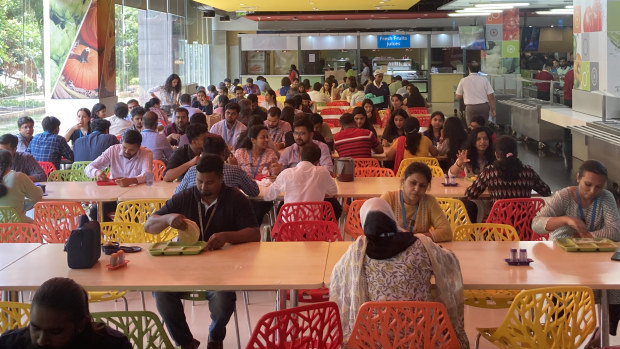NAB and CBA look to India to build AI powers
Two of Australia’s biggest banks, National Australia Bank and the Commonwealth Bank of Australia, will dramatically increase the size of their Indian operations, cutting down their reliance on external IT suppliers to build a bigger army of internal tech stars on the subcontinent.
NAB is poised to add up to 3000 staff to its Indian operations – which hints at problems for suppliers such as IBM, Genpact and Infosys, which currently provide significant numbers of workers for the bank in India – as it plans to conduct higher-value work in its offshore innovation centre outside of Delhi.

NAB and CBA are expanding their offshore IT centres in India as they bring previously outsourced work in-house.
“We have around 3000 third-party contractor resources in India that we’ve worked with for over 15 years, and we also want to bring some of them in-house and make them NAB employees,” said Patrick Wright, NAB group executive for technology and enterprise operations.
CBA, meanwhile, has been expanding its tech-focused Indian operations since 2019, when it followed ANZ Bank’s lead to set up expansive centres in India by poaching its top Indian executive Pankajam Sridevi.
CBA currently has 3500 staff working in a business park in Bangalore, where it is looking for new premises to expand its Indian tech ranks by 1500 people to take it to 5000 staff. Local sources say CBA is seeking an option on a lease that could expand headcount to 10,000 people down the track.
AI skills
India is no longer only providing back-office support for banks. The work being conducted there is of central importance to banks’ core operations, including assessing loans, running payments systems and developing customer-facing apps.

NAB chief technology officer Patrick Wright. “We have tap into global capabilities to find the skills we need.” Eamon Gallagher
The banks are hiring highly skilled engineers, architects and business analysts and are particularly keen to tap Indian expertise in emerging areas like artificial intelligence.
NAB’s Indian operations in Gurugram, near Delhi – which focuses on cybersecurity, operations, lending services and payments – are part of a move to in-source work traditionally outsourced to tech vendors.
In 2018, NAB had around 70 per cent of its technology workforce outsourced, but by last year, that was down to around 37 per cent, and the number will continue to fall. It also has offshore Vietnamese IT teams in Ho Chi Minh City and Hanoi.
Late to the gane
Founder and managing director of AI and automation specialist consulting firm Mindfields, Mohit Sharma, who formerly advised large organisations on outsourcing strategies, said the Australian banks were relatively late to the game in India, but that there was logic to NAB and CBA’s increasing investments.
Referring to the Indian operations in the industry parlance as “captive centres,” he said the most obvious opportunity came in transferring staff from existing outsourcing suppliers.
He suggested banks would be better off focusing on automating the kind of work being conducted offshore.
“American Express and General Electric set up their captives in India in 1997 when labour arbitrage was more than 150 per cent, so NAB is only late by 25 years,” Mr Sharma said.
Across the banks, new workers fresh out of an Indian technical colleague or university start on about $30,000 a year; between one-third and half of what a similar graduate might pull in Melbourne or Sydney.
But wage costs are rising as numerous global banks and a broad range of Western companies beyond financial services compete for India’s best talent.
Mr Sharma said the price of tech experts in India had grown markedly recently due to high demand from big-name European and US companies, and a vibrant young domestic tech start-up scene, that has already spawned over “unicorn” firms valued at more than $1 billion.

ANZ staff lunching at the cafeteria in its Bangalore operations centre in India in June. CBA poached the former head of ANZ’s operations to build up operations there. AFR
“The labour arbitrage story is now over, as a Starbucks coffee in India is 60 per cent more expensive than Australia. This price difference in basic consumer items will be reflected in salary increases in the next three years, which could result in a negative business case for setting up captives,” he said.
Valuable talent pool
Even if salary costs and competition for staff are rising, banks feel they still need to be in India to tap its huge computer engineering talent pool: the country produces about 1.5 million information technology graduates a year, including 100,000 in Bangalore alone.
“In Australia, great technology and digital talent remains highly sought after. Combine that with unemployment rates falling to the lowest levels in nearly 50 years recently and this means we have to tap into global capabilities to find the skills we need,” Mr Wright said.
A CBA spokesman said its operations in India “provides us with a large-scale pool of talent and direct access to world-leading expertise, particularly in the fields of technology and operations, and a location in a time zone that allows us to extend our operating window”.
“Since its establishment, we have built our team there primarily with staff who have moved over from our partner organisations in India and those who have been hired in newly created roles,” the CBA spokesman said. “We continue to look at opportunities to grow CBA India, given the access to skills and talent that the region offers.”
Relatively small
Despite the Indian operations of Australian banks being significant in Australian terms, Mr Sharma said they pale alongside big global operators like JPMorgan and American Express, which have more than 100,000 employees in their Indian centres.
ANZ has 8000 people in India, working in two offices in Bangalore, representing 20 per cent of its total workforce. Their jobs include processing mortgage applications, crunching data for the bank’s economics team and preparing reports for Australian regulators.
Macquarie, operating in India since 2008, has a team of around 1800 people, also in Gurugram, and a smaller Mumbai office. They support the bank in areas including finance, risk, technology, equities and asset management.
Mr Sharma said NAB should have automated middle and lower operational jobs before sending them to their captive.
“Transferring jobs from their current outsourcing vendors like IBM, Genpact and Infosys to NAB’s captive is an opportunity, as unfortunately these vendors have automated less than 5 per cent of their workforce,” he said.
“The real opportunity for NAB would be to, efficiently and effectively, adopt AI and automation to remove mundane human intensive tasks in Australia.”
Introducing your Newsfeed
Follow the topics, people and companies that matter to you.
Find out moreRead More
Latest In Technology
Fetching latest articles